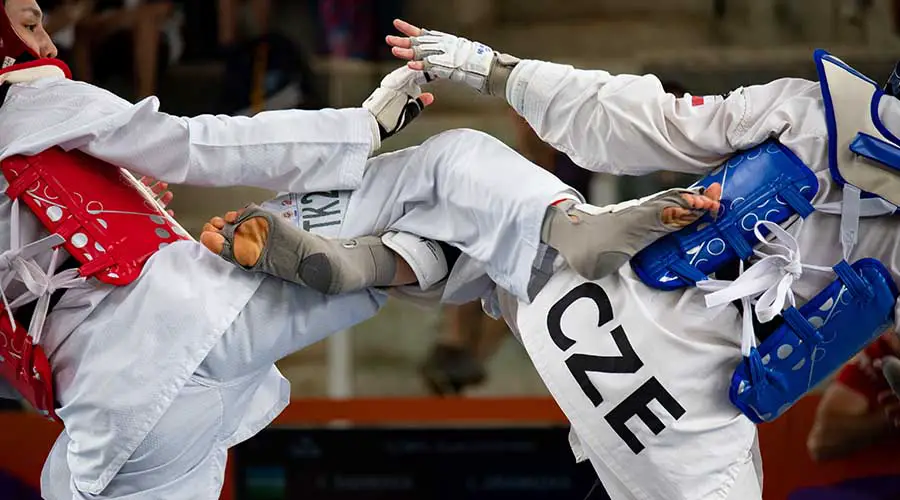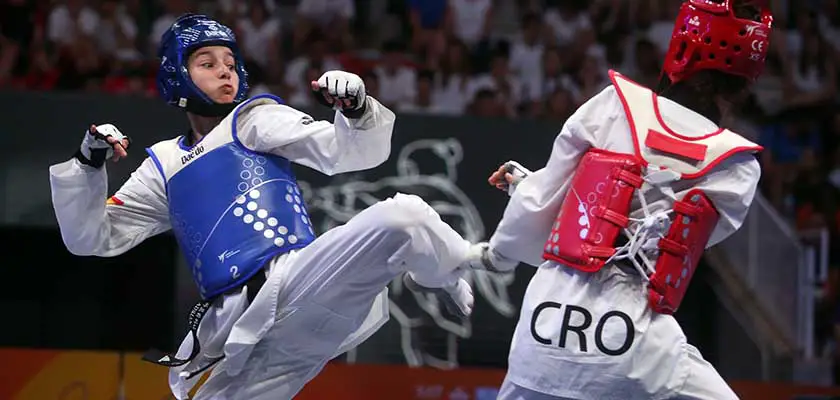Taekwondo is a martial art of Korean origin based on the use of the feet and hands to strike an opponent. It has been an Olympic sport since 2000, when it made its debut at the Sydney Games.
Just like any other sport, taekwondo is governed by a set of rules that aim to make fighting fair and safe.
So, in this complete and up-to-date guide, we’ll explain the main rules of taekwondo, such as the scoring system, types of infractions, mandatory equipment and the duration of fights.
Check it out 👇
Taekwondo rules
- Taekwondo fundamentals
- Taekwondo fighting duration
- Taekwondo scoring system
- Taekwondo referees
- Taekwondo win conditions
- Taekwondo tie-break
- Taekwondo prohibited techniques
- Taekwondo penalties
- Taekwondo combat area
- Taekwondo equipment
- Taekwondo weight classes
Taekwondo fundamentals

Taekwondo is a South Korean martial art known for its kicking and punching techniques. In tournaments, athletes earn points for applying precise and controlled techniques to their opponents, without using violence.
In general, the match is won by whoever has the most points at the end of regulation time. The points are calculated using sensors installed in the competitors’ chest and head protections.
In this way, when a blow is struck, the chips detect the impact and automatically update the fight score.
Taekwondo fighting duration
According to taekwondo rules, the fights consist of three rounds of two minutes each. In between each round, competitors have one minute to rest, review tactics and talk to coaches.
Taekwondo scoring system
- Punch to the chest – 1 point
- Kick to the chest – 2 points
- Kick to the head – 3 points
- Spinning kick to the chest – 4 points
- Spinning kick to the head – 5 points
Taekwondo referees
Despite the technology, referees are called in to supervise the fights and make sure everything is running smoothly. According to taekwondo rules, the judges can issue penalties and review controversial moves.
Taekwondo win conditions
- More points than the opponent at the end of regulation time
- Reaching 20 points difference at the end of the second round
- Knocking out the opponent
- Winning by disqualification of the opponent
Taekwondo tie-break

If the competitors finish the regulation time tied on points, a fourth round of one minute is played.
In this kind of extra time, according to taekwondo rules, the first competitor to score two points is declared the winner of the match.
If the tie persists, the decision is left to the referees, who will use specific criteria to select the winner.
Taekwondo prohibited techniques
- Crossing the boundary line of the combat area
- Falling to the ground
- Avoiding the fight
- Holding or pushing the opponent
- Landing kicks below the waist
- Striking the head with the hands
- Headbutting the opponent
- Attacking a fallen opponent
- Raising the leg to block
- Kicking the opponent’s leg to stop a blow
- Raising your leg or kicking the air for more than three seconds
Taekwondo penalties
According to taekwondo rules, when a competitor performs any of the prohibited actions listed above, they are penalised with a foul. These can be of two types: kyong-go (light) and gam-jeom (heavy).
A kyong-go earns the opponent half a point. A gam-jeom earns the opponent one point. This bonus is a way of raising awareness among athletes.
A fighter can only accumulate seven kyong-go and three gam-jeom per match. If they exceed these limits, they are automatically disqualified.
Taekwondo combat area
The taekwondo combat arena is a square with a side of 8 metres. Around it is a perimeter called the safety area, which should measure 2 metres.
This area serves to delimit the combat area. If athletes cross the safety line, they can be penalised.
Taekwondo equipment

In the duels, the competitors must wear protectors on their chests, heads, legs and genitals. This equipment must be placed on top of the dobok, which is the taekwondo fighting garment.
To differentiate themselves in combat, one athlete wears red protectors, while the other wears blue protectors. According to taekwondo rules, they are called hong and tchong respectively.
Taekwondo weight classes
- Male flyweight: up to 58kg
- Women’s flyweight: up to 49 kg
- Men’s lightweight: between 58 and 68 kg
- Women’s lightweight: between 49 and 57 kg
- Men’s middleweight: between 68 and 80 kg
- Women’s middleweight: between 57 and 67 kg
- Men’s heavyweight: over 80 kg
- Women’s heavyweight: over 67 kg
Now you know all the rules of taekwondo and are ready to watch the fights at the Olympics! Did you like this content? Let us know what you think in the comments! And keep visiting us daily, eh? 👊



